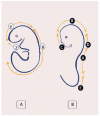Spinal Dermoid and Epidermoid Cyst: An Institutional Experience and Clinical Insight into the Neural Tube Closure Models
- PMID: 34295103
- PMCID: PMC8289537
- DOI: 10.1055/s-0041-1724229
Spinal Dermoid and Epidermoid Cyst: An Institutional Experience and Clinical Insight into the Neural Tube Closure Models
Abstract
Objectives The spinal dermoid and epidermoid cysts (SDECs) are rare entities comprising less than 1% of pediatric intraspinal tumors. The present study aims to extrapolate the clinicoradiological data, in order to identify the most plausible neural tube closure model in human and provide a retrospective representation from our clinical experience. Materials and Methods We collected the details of all histologically proven, newly diagnosed primary SDECs who underwent excision over the past 20 years. Secondary or recurrent lesions and other spinal cord tumors were excluded. Surgical and follow-up details of these patients as well as those with associated spinal dysraphism were reviewed. Clinical and radiological follow-up revealed the recurrence in these inborn spinal cord disorders. Results A total of 73 patients were included retrospectively, having a mean age of 22.4 ± 13.3 years, and 41 (56.2%) cases fell in the first two decades of life. Twenty-four (32.9%) dermoid and 49 (67.1%) epidermoid cysts comprised the study population and 20 of them had associated spinal dysraphism. The distribution of SDECs was the most common in lumbosacral region ( n = 30) which was 10 times more common than in the sacral region ( n = 3). Bladder dysfunction 50 (68.5%) and pain 48 (65.7%) were the most common presenting complaints. During follow-up visits, 40/48 (83.3%) cases showed sensory improvement while 11/16 (68.7%) regained normal bowel function. There was no surgical mortality with recurrence seen in eight till the last follow-up. Conclusions The protracted clinical course of the spinal inclusion cysts mandates a long-term follow-up. The results of our study support the multisite closure model and attempt to provide a retrospective reflection of neural tube closure model in humans by using SDECs as the surrogate marker of neural tube closure defect.
Keywords: bladder dysfunction; dermoid; epidermoid; spinal cord tumor; spinal dysraphism.
Association for Helping Neurosurgical Sick People. This is an open access article published by Thieme under the terms of the Creative Commons Attribution-NonDerivative-NonCommercial-License, permitting copying and reproduction so long as the original work is given appropriate credit. Contents may not be used for commercial purposes, or adapted, remixed, transformed or built upon. (https://creativecommons.org/licenses/by-nc-nd/4.0/.).
Conflict of interest statement
Conflict of Interest None declared.
Figures





References
-
- Roux A, Mercier C, Larbrisseau A. Dube LJ, Dupuis C, Del Carpio R. Intramedullary epidermoid cysts of the spinal cord. Case report. J Neurosurg. 1992;76(03):528–533. - PubMed
-
- Van Allen M I, Kalousek D K, Chernoff G F et al.Evidence for multi-site closure of the neural tube in humans. Am J Med Genet. 1993;47(05):723–743. - PubMed
-
- Golden J A, Chernoff G F. Anterior neural tube in the mouse: fuel for disagreement with the classical theory. Clin Res. 1983;31:127A.
-
- Juriloff D M, Harris M J, Tom C, MacDonald K B. Normal mouse strains differ in the site of initiation of closure of the cranial neural tube. Teratology. 1991;44(02):225–233. - PubMed
-
- van Straaten H WM, Peeters M CE, Hekking J WM, van der Lende T. Neurulation in the pig embryo. Anat Embryol (Berl) 2000;202(02):75–84. - PubMed
LinkOut - more resources
Full Text Sources
Miscellaneous

